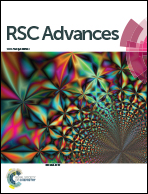The fast nucleation/growth of Co3O4 nanowires on cotton silk: the facile development of a potentiometric uric acid biosensor
Abstract
In this study, we have used cotton silk as a source of abundant hydroxyl groups for the fast nucleation/growth of cobalt oxide (Co3O4) nanowires via a hydrothermal method. The crystal planes of the Co3O4 nanowires well matched the cubic phase. The as-synthesized Co3O4 nanowires mainly contained cobalt and oxygen elements and were found to be highly sensitive towards uric acid in 0.01 M phosphate buffer solution at pH 7.4. Importantly, the Co3O4 nanowires exhibited a large surface area, which was heavily utilized during the immobilization of the enzyme uricase via a physical adsorption method. The potentiometric response of the uricase-immobilizing Co3O4 nanowires was measured in the presence of uric acid (UA) against a silver/silver chloride (Ag/AgCl) reference electrode. The newly fabricated uric acid biosensor possessed a low limit of detection of 1.0 ± 0.2 nM with a wide linear range of 5 nM to 10 mM and sensitivity of 30.6 mV dec−1. Additionally, several related parameters of the developed uric acid biosensor were investigated, such as the repeatability, reproducibility, storage stability, selectivity, and dynamic response time, and these were found to be satisfactory. The good performance of the Co3O4 nanowires was verified based on the fast charge-transfer kinetics, as confirmed via electrochemical impedance spectroscopy. The successful practical use of the uric acid biosensor was demonstrated based on the recovery method. The observed performance of the uricase-immobilizing Co3O4 nanowires revealed that they could be considered as a promising and alternative tool for the detection of uric acid under both in vitro and in vivo conditions. Also, the use of cotton silk as a source of abundant hydroxyl groups may be considered for the remarkably fast nucleation/growth of other metal-oxide nanostructures, thereby facilitating the fabrication of functional electrochemical devices, such as batteries, water-splitting devices, and supercapacitors.



 Please wait while we load your content...
Please wait while we load your content...